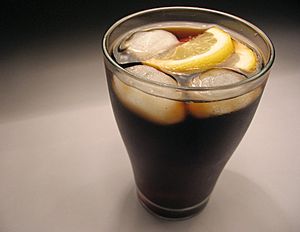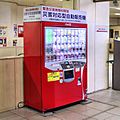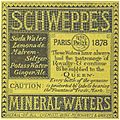Soft drink facts for kids

Soft drinks are sweet, fizzy drinks that many people enjoy. They are also called soda, pop, or fizzy drinks in different places. These drinks get their bubbles from a process called carbonation. This means they have carbon dioxide gas mixed into them, which makes them bubbly.
Soft drinks are usually made from special liquid concentrates. These concentrates are mixed with water and lots of sugar to give them their sweet taste. Some popular kinds of soft drinks you might know are Sprite, Mountain Dew, 7 Up, Pepsi, Dr Pepper, and Coca-Cola.
Contents
What Are Soft Drinks?
Soft drinks are different from other drinks like milk or juice because they are often made in factories. They usually contain:
- Carbonated water: This is water with bubbles of carbon dioxide gas.
- Sweeteners: Most soft drinks use sugar to make them sweet. Sometimes, they use artificial sweeteners instead.
- Flavorings: These give the drink its taste, like cola, lemon-lime, or orange.
- Colors: Many soft drinks have added colors to make them look appealing.
Why Are They Called "Soft"?
The name "soft drink" helps us tell them apart from "hard drinks." Hard drinks are alcoholic drinks, like beer or wine. Soft drinks do not contain any alcohol, which makes them "soft."
How Do They Get Their Bubbles?
The bubbles in soft drinks come from carbon dioxide gas. This gas is put into the drink under high pressure. When you open a bottle or can of soda, the pressure is released. This allows the carbon dioxide gas to escape, creating all those fun bubbles and the fizzing sound. This process is called carbonation.
A Brief History of Soft Drinks
People have enjoyed bubbly drinks for a long time.
- Natural bubbly water: In the past, people drank naturally bubbly water from special springs. They believed it had health benefits.
- Making bubbly water: In the late 1700s, scientists learned how to add carbon dioxide to water. This meant they could make bubbly water whenever they wanted.
- Adding flavors: Soon, people started adding flavors to this bubbly water. This was the beginning of modern soft drinks.
- Bottling drinks: By the 1800s, companies began to bottle soft drinks. This made it easier to sell and transport them. The Codd-neck bottle, invented in 1872, was a clever way to keep the fizz inside.
Are Soft Drinks Healthy?
Most soft drinks have a lot of sugar. Drinking too much sugar can lead to several health issues.
- Tooth decay: The sugar and acids in soft drinks can harm your teeth.
- Weight gain: The extra sugar adds calories, which can lead to gaining too much weight.
- Other health concerns: Regular consumption of sugary drinks can also be linked to other health problems over time.
It's important to drink soft drinks in moderation. Choosing water, milk, or unsweetened juices more often is a healthier choice for your body.
Images for kids
-
Soft drink vending machine in Japan
-
Bubbles of carbon dioxide float to the surface of a carbonated soft drink
-
An 1883 advertisement for Schweppes Mineral-Waters
-
The Codd-neck bottle invented in 1872 provided an effective seal, preventing the soft drinks from going 'flat'
-
A mid-20th century jug of bottler's flavor for 7-Up. The syrup-like concentrate lacked sugar and was sold to franchisees in such glass containers to produce the soft drink for retail sale
See also
 In Spanish: Gaseosa para niños
In Spanish: Gaseosa para niños









